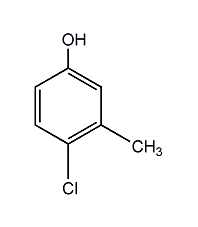4-Chloro-3-methylphenol 4-Chloro-3-methylphenol


Structural formula
| Business number | 01AG |
|---|---|
| Molecular formula | C7H7ClO |
| Molecular weight | 142.58 |
| label |
4-Chloro-3-methylphenol, 4-chlorom-cresol, 4-Chloro-3-methylphenol, PCMC, Fungicide |
Numbering system
CAS number:59-50-7
MDL number:MFCD00002323
EINECS number:200-431-6
RTECS number:GO7100000
BRN number:1237629
PubChem number:24892794
Physical property data
1. Properties: Colorless crystals. Extremely pure products are odorless, often with a phenol smell. Can evaporate with water vapor.
2. Density (g/mL, 25/4℃): Undetermined
3. Relative vapor density (g/mL, air=1): Undetermined
4. Melting point (ºC): 66~68
5. Boiling point (ºC, normal pressure): 235
6. Boiling point (ºC, 5.2kPa): Not available Determined
7. Refractive index: Undetermined
8. Flash point (ºC): 160
9. Specific rotation (º): Undetermined
10. Autoignition point or ignition temperature (ºC): Undetermined
11. Vapor pressure (kPa, 25ºC): Undetermined
12. Saturated vapor Pressure (kPa, 60ºC): Undetermined
13. Heat of combustion (KJ/mol): Undetermined
14. Critical temperature (ºC): Undetermined
15. Critical pressure (KPa): Undetermined
16. Log value of oil-water (octanol/water) partition coefficient: Undetermined
17. Explosion upper limit (%, V/V): Undetermined
18. Lower explosion limit (%, V/V): Undetermined
19. Solubility: 20℃, 1g product dissolves in 260ml water, Slightly more soluble in hot water, easily soluble in ethanol, ether, benzene, acetone, chloroform and petroleum ether. Its aqueous solution turns yellow in light and air.
Toxicological data
1. Acute toxicity: rat oral LD50: 1830mg/kg; rat subcutaneous LD50: 400mg/kg; mouse oral LC50: 600mg/kg; mouse subcutaneous LC50: 360mg/kg; mouse intravenous LC50: 70mg/ kg2, other multiple dose toxicity: rat oral TDLo: 11200mg/kg/28D-I3, mutagenicity: mutation microorganismsTEST system: bacteria – Salmonella typhimurium: 25ug/plate; Mutation test system – not other specifiedTEST system: bacteria -E. coli: 100umol/L
Ecological data
None yet
Molecular structure data
1. Molar refractive index: 37.85
2. ��� Mol volume (cm3/mol): 116.0
3. Isotonic specific volume (90.2K): 295.8
4. Surface tension (dyne/ cm): 42.1
5. Polarizability (10-24cm3): 15.00
Compute chemical data
1. Reference value for hydrophobic parameter calculation (XlogP): None
2. Number of hydrogen bond donors: 1
3. Number of hydrogen bond acceptors: 1
4. Number of rotatable chemical bonds: 0
5. Number of tautomers: 6
6. Topological molecule polar surface area 20.2
7. Number of heavy atoms: 9
8. Surface charge: 0
9. Complexity: 94.9
10. Number of isotope atoms: 0
11. Determine the number of atomic stereocenters: 0
12. Uncertain number of atomic stereocenters: 0
13. Determine the number of chemical bond stereocenters: 0
14. Number of uncertain chemical bond stereocenters: 0
15. Number of covalent bond units: 1
Properties and stability
Best range of use: It is more active in acidic media than in alkaline media. Its aqueous solution will turn yellow when exposed to light or contact with air. The presence of non-ionic surfactants will partially deactivate it and cause it to change color when exposed to iron salts.
Storage method
This product should be sealed and stored away from light.
Synthesis method
1. Reaction of m-cresol and dichlorosulfonyl. Under stirring, slowly add m-cresol to dichlorosulfonyl, and control the reaction temperature at 30-50°C. After adding, keep it warm for 16 hours, wash with water, wash with sodium carbonate solution until alkaline, and then wash with hot water until neutral. Separate the oil layer and dry it with anhydrous calcium chloride, filter out the desiccant and distill under reduced pressure. Pour the distillate into petroleum ether, cool, filter and dry to obtain the finished product.
Purpose
1. Antisepsis and disinfection. Used in organic synthesis, such as dyes, film preservatives, etc.
2.It is used as a preservative in protein shampoos and baby cosmetics, with a usage content (mass fraction) of 0.1% to 0.2%. The maximum allowable dosage (mass fraction) is 0.2%. It is also used in organic synthetic raw materials, pigment intermediates and film preservatives.